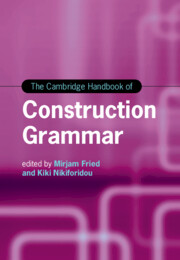Book contents
- The Cambridge Handbook of Construction Grammar
- Cambridge Handbooks in Language and Linguistics
- The Cambridge Handbook of Construction Grammar
- Copyright page
- Contents
- Figures
- Tables
- Contributors
- Acknowledgments
- Construction Grammar
- Part I The Constructional View of Language
- Part II Methodological and Empirical Foundations of Constructional Research
- Part III Case Studies in Constructional Morphosyntax
- Part IV Multimodality and Construction Grammar
- Part V Constructions in Sociocultural and Typological Variation
- 17 Constructions in Typological and Cross-Linguistic Context
- 18 Constructions and Language Contact
- 19 Constructions and Lectal Variation
- 20 Construction Discourse
- Part VI Constructional Applications
- Index of Terms
- Index of Languages
- Index of Constructions
- References
17 - Constructions in Typological and Cross-Linguistic Context
from Part V - Constructions in Sociocultural and Typological Variation
Published online by Cambridge University Press: 30 January 2025
- The Cambridge Handbook of Construction Grammar
- Cambridge Handbooks in Language and Linguistics
- The Cambridge Handbook of Construction Grammar
- Copyright page
- Contents
- Figures
- Tables
- Contributors
- Acknowledgments
- Construction Grammar
- Part I The Constructional View of Language
- Part II Methodological and Empirical Foundations of Constructional Research
- Part III Case Studies in Constructional Morphosyntax
- Part IV Multimodality and Construction Grammar
- Part V Constructions in Sociocultural and Typological Variation
- 17 Constructions in Typological and Cross-Linguistic Context
- 18 Constructions and Language Contact
- 19 Constructions and Lectal Variation
- 20 Construction Discourse
- Part VI Constructional Applications
- Index of Terms
- Index of Languages
- Index of Constructions
- References
Summary
Construction Grammar and typology share many assumptions and each approach can fruitfully inform the other. Both fields start from a pairing of form and function and treat lexicon, morphology, and syntax as a continuum of varying strategies to express function. Cross-linguistic comparison leads to a distinction between language-particular categories and structures, determined by distributional analysis, and comparative concepts that are cross-linguistically valid. Strategies are morphosyntactic formal structures that are defined language-independently and constructions are comparative concepts; as such, constructions and their components can be aligned across languages, and strategies allow the alignment of morphosyntactic structures used for constructions across languages. Typologists have also developed representations of the conceptual relations between the functions of different constructions in terms of conceptual spaces. Typological diversity also suggests that the only universal syntactic structure is the part–whole relation between a construction and its constituents. Both Construction Grammar and typology give a prominent role to diachrony, seeing constructions as lineages.
Keywords
- Type
- Chapter
- Information
- The Cambridge Handbook of Construction Grammar , pp. 439 - 468Publisher: Cambridge University PressPrint publication year: 2025

